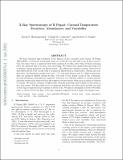| dc.contributor.author | Huenemoerder, David P. | |
| dc.contributor.author | Canizares, Claude R. | |
| dc.contributor.author | Schulz, Norbert S. | |
| dc.date.accessioned | 2013-01-07T21:42:37Z | |
| dc.date.available | 2013-01-07T21:42:37Z | |
| dc.date.issued | 2001-10 | |
| dc.date.submitted | 2001-03 | |
| dc.identifier.issn | 0004-637X | |
| dc.identifier.issn | 1538-4357 | |
| dc.identifier.uri | http://hdl.handle.net/1721.1/76180 | |
| dc.description.abstract | We have obtained high-resolution X-ray spectra of the coronally active binary II Pegasi (HD 224085), covering the wavelength range of 1.5-25 Å. For the first half of our 44 ks observation, the source was in a quiescent state with constant X-ray flux, after which it flared, reaching twice the quiescent flux in 12 ks, then decreased. We analyze the emission-line spectrum and continuum during quiescent and flaring states. The differential emission measure derived from lines fluxes shows a hot corona with a continuous distribution in temperature. During the nonflare state, the distribution peaks near log T = 7.2, and when flaring, it peaks near 7.6. High-temperature lines are enhanced slightly during the flare, but most of the change occurs in the continuum. Coronal abundance anomalies are apparent, with iron very deficient relative to oxygen and significantly weaker than expected from photospheric measurements, while neon is enhanced relative to oxygen. We find no evidence of appreciable resonant scattering optical depth in line ratios of iron and oxygen. The flare light curve is consistent with solar two-ribbon flare models but with a very long reconnection time constant of about 65 ks. We infer loop lengths of about 0.05 to about 0.25 stellar radii in the flare, if the flare emission originated from a single, low-density loop. | en_US |
| dc.description.sponsorship | United States. National Aeronautics and Space Administration (Contract NAS 8-38249) | en_US |
| dc.description.sponsorship | United States. National Aeronautics and Space Administration (Contract SVI-61010) | en_US |
| dc.language.iso | en_US | |
| dc.publisher | IOP Publishing | en_US |
| dc.relation.isversionof | http://dx.doi.org/10.1086/322419 | en_US |
| dc.rights | Article is made available in accordance with the publisher's policy and may be subject to US copyright law. Please refer to the publisher's site for terms of use. | en_US |
| dc.source | arXiv link from Prof. Canizares | en_US |
| dc.title | X-Ray Spectroscopy of II Pegasi: Coronal Temperature Structure, Abundances, and Variability | en_US |
| dc.type | Article | en_US |
| dc.identifier.citation | Huenemoerder, David P., Claude R. Canizares, and Norbert S. Schulz. “X‐Ray Spectroscopy of II Pegasi: Coronal Temperature Structure, Abundances, and Variability.” The Astrophysical Journal 559.2 (2001): 1135–1146. | en_US |
| dc.contributor.department | MIT Kavli Institute for Astrophysics and Space Research | en_US |
| dc.contributor.approver | Canizares, Claude R. | |
| dc.contributor.mitauthor | Huenemoerder, David P. | |
| dc.contributor.mitauthor | Canizares, Claude R. | |
| dc.contributor.mitauthor | Schulz, Norbert S. | |
| dc.relation.journal | Astrophysical Journal | en_US |
| dc.eprint.version | Author's final manuscript | en_US |
| dc.type.uri | http://purl.org/eprint/type/JournalArticle | en_US |
| eprint.status | http://purl.org/eprint/status/PeerReviewed | en_US |
| dspace.orderedauthors | Huenemoerder, David P.; Canizares, Claude R.; Schulz, Norbert S. | en |
| dc.identifier.orcid | https://orcid.org/0000-0002-5769-8441 | |
| mit.license | PUBLISHER_POLICY | en_US |
| mit.metadata.status | Complete | |
